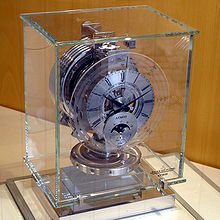
Atmos is the brand name of a mechanical torsion pendulum clock manufactured by Jaeger-LeCoultre in Switzerland. The clock gets the energy it needs to run from temperature changes in the environment and does not need to be wound manually. It can run for years without human intervention.
The mechanism is driven by a mainspring, which is wound by the expansion and contraction of liquid and gaseous ethyl chloride in an internal hermetically sealed metal bellows. The ethyl chloride vaporises into an expansion chamber as the temperature rises, compressing a spiral spring; with a fall in temperature the gas condenses and the spiral spring expands, winding the mainspring.[1][2] This motion constantly winds the mainspring. A temperature variation of only one degree in the range between 15 °C (59 °F) and 30 °C (86 °F), or a pressure variation of 3 mmHg, was calculated to provide energy for two days' operation for an early prototype,[3] while for a more recent Atmos 540 model the corresponding value has been computed as 4.3 days per °C.[4]
To run the clock on this small amount of energy, everything in the Atmos must be as friction-free as possible. For timekeeping it uses a torsion pendulum, which consumes less energy than an ordinary pendulum. The torsion pendulum has a period of precisely one minute; thirty seconds to rotate in one direction and thirty seconds to return to the starting position. This is thirty times slower than the 0.994 m (39.1 in) seconds pendulum typically found in a longcase clock, where each swing (or half-period) takes one second.
- ^ Sacks, Adam Michael (22 April 2007), "How the Atmos works", The Atmos Clock Page, Los Angeles: atmosadam.com, retrieved 2007-12-08
- ^ Forster, Jack (11 June 2015). "The Value Proposition: The Amazing, Incredible, And Semi-Affordable Atmos Clock From Jaeger-LeCoultre". Hodinkee. Retrieved 2024-11-15.
- ^ Callaway, Edgar H. (2003). Wireless Sensor Networks: Architectures and Protocols. Boca Raton, FL: CRC Press. pp. 157–158. ISBN 978-0-8493-1823-8.
- ^ Moline, D.; J. R. Wagner (2015). "Operating Principles, Common Questions, and Performance Data for an Atmospheric Driven Atmos Clock". NAWCC bulletin.